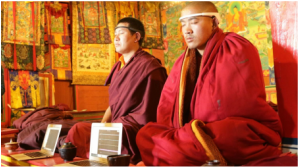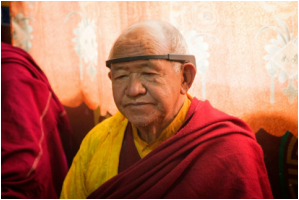Meditation and Mindfulness
|
"To the best of our knowledge, this is the first paper that shows rapid alterations in gene expression within subjects associated with mindfulness meditation practice," says study author Richard J. Davidson, founder of the Center for Investigating Healthy Minds and the William James and Vilas Professor of Psychology and Psychiatry at the University of Wisconsin-Madison.
The study compared the effects of a single day of intensive mindfulness practice between a group of experienced meditators and a group of untrained control subjects who engaged in quiet non-meditative activities. After an intensive day of mindfulness practice, the meditators showed a dramatic range of genetic and molecular differences. Meditation was found to alter levels of gene-regulating machinery and reduced levels of pro-inflammatory genes, which in turn correlated with faster physical recovery from a stressful situation. "Most interestingly, the changes were observed in genes that are the current targets of anti-inflammatory and analgesic drugs," says Perla Kaliman, first author of the article and a researcher at the Institute of Biomedical Research of Barcelona in Spain, where the molecular analyses were conducted. Although one group were experienced meditators, the researchers were surprised to find that there was no difference in the tested genes between the two groups of people at the beginning of the study. The observed effects were seen only in the meditators following mindfulness practice. In addition, several other DNA-modifying genes showed no differences between groups, suggesting that the intensive mindfulness session specifically affected certain regulatory pathways. In past studies, mindfulness-based training has been shown to have beneficial effects on inflammatory disorders. Meditation is endorsed by the American Heart Association as an effective way to lower your risk for heart disease which is the leading cause of death in the United States. The new results provide a possible explanation for the biological mechanism behind the therapeutic benefits of meditation. Source: The degree to which some of these genes were downregulated was associated with faster cortisol recovery to a social stress test which involved making mental calculations, public speaking, and performing other impromptu tasks in front of an audience and video camera. Meditation Produces Powerful Pain-Relief article continues after advertisementAnother study from April 2011 found that meditation produces powerful pain-relieving effects in the brain. The findings were published in the Journal of Neuroscience. At the time, Fadel Zeidan, Ph.D., lead author of the study and post-doctoral research fellow at Wake Forest Baptist Medical Center said, "This is the first study to show that only a little over an hour of meditation training can dramatically reduce both the experience of pain and pain-related brain activation." Zeidan said, "We found a big effect—about a 40 percent reduction in pain intensity and a 57 percent reduction in pain unpleasantness. Meditation produced a greater reduction in pain than even morphine or other pain-relieving drugs, which typically reduce pain ratings by about 25 percent." Source: During brain scans, a pain-inducing heat device was placed on the participants' right legs. This device heated a small area of their skin to 120° Fahrenheit, a temperature that most people find painful, over a 5-minute period. "The scans taken after meditation training showed that every participant's pain ratings were reduced, with decreases ranging from 11 to 93 percent," Zeidan said. At the same time, meditation significantly reduced brain activity in the primary somatosensory cortex, a brain area that is involved in creating the feeling of the locatin and intensity of a painful stimulus. The scans taken before meditation training showed activity in this area was very high. However, when participants were meditating during the scans, activity in this pain-processing region could not be detected.
1 Comment
 The Winter Feast for the Soul is an annual spiritual practice period that begins every January 15. During the Feast, thousands of people worldwide recommit to their spiritual practice every day for 40 days to cultivate personal peace. Peace on earth can only arise from peace in one’s heart. The Feast was inspired by the words of the Persian poet, Jelaluddin Rumi, who wrote, “What nine months does for the embryo, forty early mornings will do for your growing awareness.” The Winter Feast for the Soul is a not-for-profit organization that offers online meditation and practice support via meditation recordings, instruction, and inspiration free of charge on its website. ,Imagine that the first thing in the morning you looked forward to sitting silently before beginning your day, before going on to FB or check email or the tv, or racing out the door in a hurry, or however you usually start your day.
To me there is nothing better than that time sitting in meditation before beginning anything else. It is a way of life, a way of embracing the new day, in a way that will make my day so much better. Nothing miraculous has to happen during that time, but by making that commitment each day I have found things go smoother, I am able to handle things with greater ease, clarity and I feel so much better throughout the day! I remember my mother getting up before everyone else. She had a incredibly busy life raising eleven kids and working. I believe that time in a "meditative state" allowed her to center herself and prepare for the day. I remember seeing her sitting there relaxed and peaceful I am sure she was not aware of meditation at that time but she knew how important that time alone in silence was and what it did for her. Love yourself and give yourself the gift of meditation. It is a gift that keeps on giving! ~ Carole Grace  When I gave a talk at Google a few months ago about using mindfulness to help relieve anxiety, depression, and other common forms of psychological distress, I was impressed by the company’s commitment to taking care of their employees. From the organic juice bars in every building to the gyms and meditation and yoga facilities scattered around the campus, it was clear that they’re thinking a healthy employee will be a productive employee (not to mention an employee who needs fewer expensive medical services). In fact, they had a whole team devoted just to teaching mindfulness meditation, and offered regular practice sessions that workers could attend either in person or online throughout the day. But can mindfulness practice really help employees’ mental health? Is it something that more businesses should be investing in, or just another fad for ex-hippies in Silicon Valley? The results of the best-designed study to date that addresses this question are just in, and the answer is impressive: mindfulness really can help workers, even those far from California. What the study found The new study comes from Taiwan, where researchers surveyed 3,270 factory workers to identify those with high levels of psychological distress. They then invited these particularly unhappy workers to participate in the study. The 144 workers who ultimately agreed to participate were assigned to either an active intervention group, in which they completed an eight-week mindfulness training program consisting of two-hour classes each week at work and 45 minutes of daily meditation homework, or a control group, who reported regularly on their psychological well-being but didn’t receive any mindfulness training. What did they find? Compared with the control group, the workers who took the mindfulness class reported feeling much better. They had less prolonged fatigue — that feeling of exhaustion that doesn’t go away even after having a chance to rest. They also felt less stressed, reported reduced anxiety and depression, and had fewer sleep difficulties, aches and pains, and problems getting along with others. So what exactly was this mindfulness training that helped them? Mindfulness involves bringing our attention into the present moment and accepting whatever is happening here and now. That sounds very simple, but when we begin to try to actually practice mindfulness — by picking a sensory experience such as the breath, bringing our attention to it, and working to accept whatever arises in our awareness — most of us find not only that our minds quickly wander off into all sorts of thoughts about the past and the future, but they also generate all sorts of negative judgments about what’s happening. The good news is that like any skill, mindfulness can be learned. It just requires a bit of instruction, and setting aside some time to practice. Numerous research studies have shown that by practicing mindfulness, we can actually change both the structure and the functioning of our brains in ways that are consistent with feeling happier and more engaged in our lives. These changes also help us to have an easier time dealing with both physical and emotional pain. How you can reap the benefits of mindfulness So how might you begin if you wanted to become more mindful? One way that doesn’t require any extra time is to simply pick a few activities, such as walking the dog, showering, or eating a meal alone, and decide to do them as mindfulness practices. That means instead of checking our smartphone, going over our to-do list, or listening to music, we try to bring our attention to the sights, sounds, and bodily sensations occurring during the activity. Since mindfulness practice is very dose-related, the more we try to do this throughout the day, the more mindful we become. While these informal practices will indeed help you to develop some mindfulness, to develop more, it’s helpful to set aside time for meditation practice, like they do at Google. Most studies documenting the effectiveness of mindfulness involve people meditating regularly. It’s easiest to begin a regular meditation practice by following recorded instructions. While there are many sources for these, you can listen for free to some that I recorded at www.mindfulness-solution.com. May you have many mindful moments! By: Olav Krigolson B.C. researchers have returned from Everest with some enlightening findings about the human brain. Scientists trekked to the remote village of Namche, Nepal in May to record the brain activity of meditating Tibetan Buddhist monks for the first time. The monastery is more than 3,400 metres above sea level and situated along the route to Mt. Everest's base camp. "If we were going to understand what was going on in their brains and gain insight into meditation then what better to do than to go the source," University of Victoria neuroscientist Olav Krigolson told CTV news Channel on Thursday. Krigolson is colead of the joint research venture between UVic and University of British Columbia. To measure monks' brain activity, Krigolson's team used a MUSE headband that records brain waves and displays them on a laptop in real time. The study of 27 monks recorded brain activity at rest, during meditation and while playing video games. Researchers found that monks' brains are still very active in meditation. Their analysis shows monks' brains were more relaxed, focused and in sync during meditation compared to when they were at rest. Krigolson said his team has found meditation also has a "carry over effect." When Monks played video games after meditating, he noticed their neurons were more responsive to visual stimuli. These findings could be helpful in keeping the brain active as people grow older. Krigolson's brain data suggests meditation would be a good idea to "stave off the effect of aging," but he said more research is needed. He's also part of an international team researching how altitude affects the body. After visiting the monastery, Krigolson continued to the Everest base camp with a physiologist to learn how they might be able to detect altitude sickness. "All this research is designed to create a picture some day about how the brain works...and there are currently a lot of missing pieces to the story," Krigolson said in a release.  The researchers outfitted the monks with brain wave monitors and asked them to meditate. (University of Victoria) |
Archives
December 2019
Categories
All
Archives |

 RSS Feed
RSS Feed 
